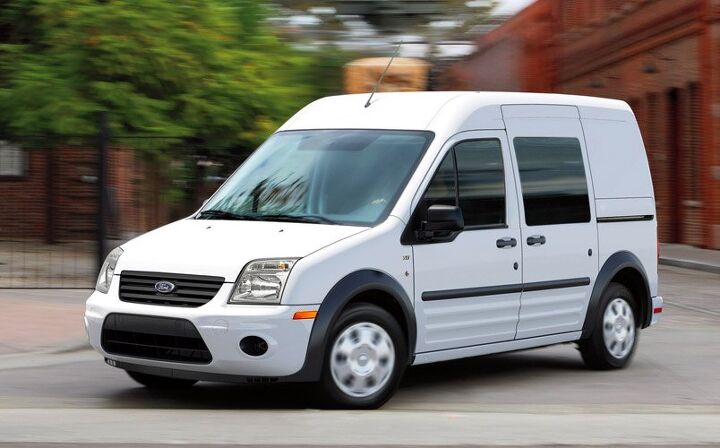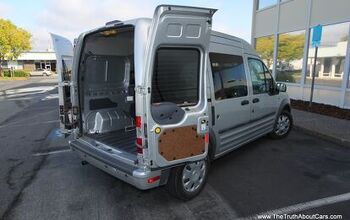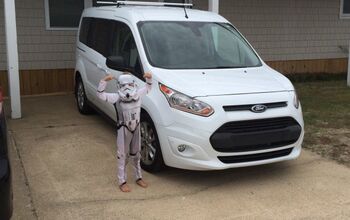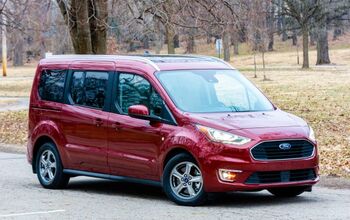Review: 2010 Ford Transit Connect Cargo XL

Down on the showroom floor, the guys talk about the “Needs-Payoff:” trying to turn a customer’s perceived need into a coveted sale. This marketing concept finds its Ford translation in the highly anticipated solution, the Transit Connect. The Blue Oval Boyz see gold in them there panel vans—assuming gas prices go north of the three dollar mark as their number crunchers and street-walking doom preachers predict. Gas prices be damned; the Transit Connect screams success for many self-made citizens, provided they don’t carry more than 1600 lb or tow anything to bring home the bacon.
Aside from the droopy-lip front bumper, Ford’s cargo van (in XL trim) succeeds where the first Dodge Caravan “CV” failed: it’s elegantly utilitarian, not frumpy and cheap. The wicked fast A-pillar climbs above the door frames for a quirky dash of style, much to the wannabe-SUV Scion xB’s disappointment. In fact, I reckon the Transit does the vanning thing like the VW Microbus. Plus, I felt so cheeky and European just standing next to it.
But automotive Mennonites rejoice, because there’s no mistaking a Transit Connect for a CUV. Hard but rich-grained plastics surround your fingers, there’s painted sheetmetal elsewhere. Ford threw in some retro masonite paneling on the rear doors for that unfinished art studio feel. Combined with the cargo’s rubber floor, RV-worthy overhead storage, perky seat fabrics and surprisingly high quality buttons and vent registers, the Transit Connect appeals to more than the ordinary work truck buyer.
Not all is perfect: the center console with floor shifter is a waste of space, especially since it lacks an armrest for the passenger seat. But (optional) features like Ford’s laptop Work Solutions system makes sitting on the Transit Connect’s modest yet accommodating bucket seats better than a day spent in your average cubicle. And it’s reasonably fun to drive, much like today’s taller, fatter Ford Focus. No surprise then, the Transit Connect handles like a hot hatchback that’s taken an Octomom-like fancy for in-vitro fertilization.
Unlike any other van, the Transit Connect corners flat in most situations, with stunning lateral grip and less push than expected from a nose heavy beast: I clipped a freeway underpass at twice the speed of our Ford Econoline tester, realizing the Transit Connect had plenty more.
And just like the Focus, there’s a 2.0L Duratec I-4 and a four-speed slushbox under the hood. The gutsy and thrash-free four cylinder made for effortless merging on a Texas highway filled with larger hauling machines. An unladen Transit Connect moves at a decent clip, but the intimidation level rises considerably when reaching the van’s cargo limit: a small-bore motor takes time to build steam when a wide ratio gearbox keeps the revs down and out for the count. Europeans will find it immediately familiar, Americans will find it slightly annoying.
So keep a loaded Transit Connect in the city and enjoy the ergonomics: the (optional) rear doors swing out 255° with the push of a button, and the mid section’s sliding doors open effortlessly, sans motorized assists. All 135 cubic feet of cargo space is easy to reach, and users shorter than six feet tall can walk inside without folding in half. If there’s enough space for a service tech and his storage shelving system back there, every other work vehicle is screwed. Sell your camper shell futures now!
But nobody’s perfect: like every other portal on the Transit Connect, opening the hood requires the ignition key. Which means you have to turn off the van to get under the bonnet. And the hood’s latch/lock combo resides under the grille’s Ford Oval. Missed that in the owner’s manual? Fear not: the instructions are under the grille’s logo, where your less-than-attentive employees cannot find it. Unless the logo is misaligned like our tester, refusing to latch shut. Hey, Europe, what’s so bad about an in-cabin hood release?
And the ignition key that opens everything is still in trouble. Lose it back beyond the radiator after opening the hood and Ford charges $200 for a replacement key, which you cannot buy anywhere but a FoMoCo dealer since it isn’t shared with another US-bound Ford product. Uh-oh.
While the Transit Connect is influenced from the USA Ford parts bin, the lessons learned from the Dodge Sprinter are obvious: component cost, availability and downtime from poor dealer training/servicing can kill Dearborn’s latest, brightest idea. Eventually.
If so, a comparable Econoline is only two grand more, and it’ll keep food on your plate if Ford turns this (showroom) hero into a (service department) zero. But let’s hope this gas-sipping global sensation gets the C-level Executive love it truly deserves, and, unlike the Ford Contour/Mondeo, meets its potential in the USA. If not, chalk up this idea with the rest of Ford’s famous American nameplates that bit the dust from corporate greed and product neglect. I’ll keep my fingers crossed.

More by Sajeev Mehta
Latest Car Reviews
Read moreLatest Product Reviews
Read moreRecent Comments
- Jeff JMII--If I did not get my Maverick my next choice was a Santa Cruz. They are different but then they are both compact pickups the only real compact pickups on the market. I am glad to hear that the Santa Cruz will have knobs and buttons on it for 2025 it would be good if they offered a hybrid as well. When I looked at both trucks it was less about brand loyalty and more about price, size, and features. I have owned 2 gm made trucks in the past and liked both but gm does not make a true compact truck and neither does Ram, Toyota, or Nissan. The Maverick was the only Ford product that I wanted. If I wanted a larger truck I would have kept either my 99 S-10 extended cab with a 2.2 I-4 5 speed or my 08 Isuzu I-370 4 x 4 with the 3.7 I-5, tow package, heated leather seats, and other niceties and it road like a luxury vehicle. I believe the demand is there for other manufacturers to make compact pickups. The proposed hybrid Toyota Stout would be a great truck. Subaru has experience making small trucks and they could make a very competitive compact truck and Subaru has a great all wheel drive system. Chevy has a great compact pickup offered in South America called the Montana which gm could be made in North America and offered in the US and Canada. Ram has a great little compact truck offered in South America as well.
- Groza George I don’t care about GM’s anything. They have not had anything of interest or of reasonable quality in a generation and now solely stay on business to provide UAW retirement while they slowly move production to Mexico.
- Arthur Dailey We have a lease coming due in October and no intention of buying the vehicle when the lease is up.Trying to decide on a replacement vehicle our preferences are the Maverick, Subaru Forester and Mazda CX-5 or CX-30.Unfortunately both the Maverick and Subaru are thin on the ground. Would prefer a Maverick with the hybrid, but the wife has 2 'must haves' those being heated seats and blind spot monitoring. That requires a factory order on the Maverick bringing Canadian price in the mid $40k range, and a delivery time of TBD. For the Subaru it looks like we would have to go up 2 trim levels to get those and that also puts it into the mid $40k range.Therefore are contemplating take another 2 or 3 year lease. Hoping that vehicle supply and prices stabilize and purchasing a hybrid or electric when that lease expires. By then we will both be retired, so that vehicle could be a 'forever car'. And an increased 'carbon tax' just kicked in this week in most of Canada. Prices are currently $1.72 per litre. Which according to my rough calculations is approximately $5.00 per gallon in US currency.Any recommendations would be welcomed.
- Eric Wait! They're moving? Mexico??!!
- GrumpyOldMan All modern road vehicles have tachometers in RPM X 1000. I've often wondered if that is a nanny-state regulation to prevent drivers from confusing it with the speedometer. If so, the Ford retro gauges would appear to be illegal.





































Comments
Join the conversation
[...] www.thetruthaboutcars.com [...]
So, while most of you are still using these vans strictly as a utility van or the dreaded "camper conversion", we've went in a different direction. Upgrading parts on our 2020 Connect like Bilstein B6 struts/shocks, 40mm rear lowering springs, NGK spark plugs and more. With the successful installation of the rear lowering springs (going from 101mm down to 40mm) Our next goal is to locate the 28mm Hardrace sway bar (designed for the Ford KUGA) and test fit this sway bar on the van which uses the same engine cradle as the KUGA. oh did I mention we also installed a set of 19'' Axe CS Lite wheels with 245/40/R19 Nokian tires. It's not slammin, but damn close.